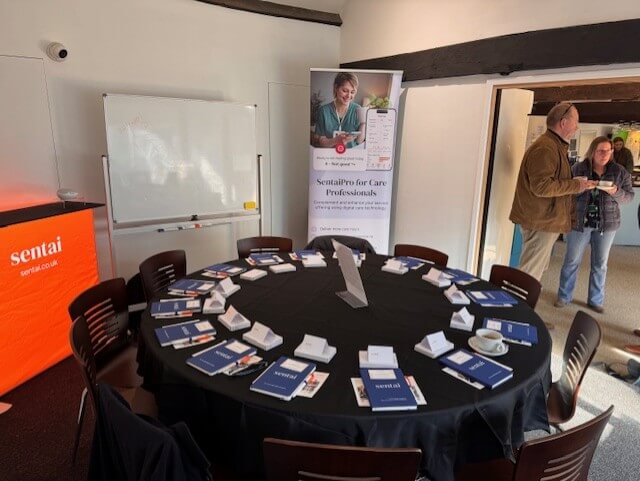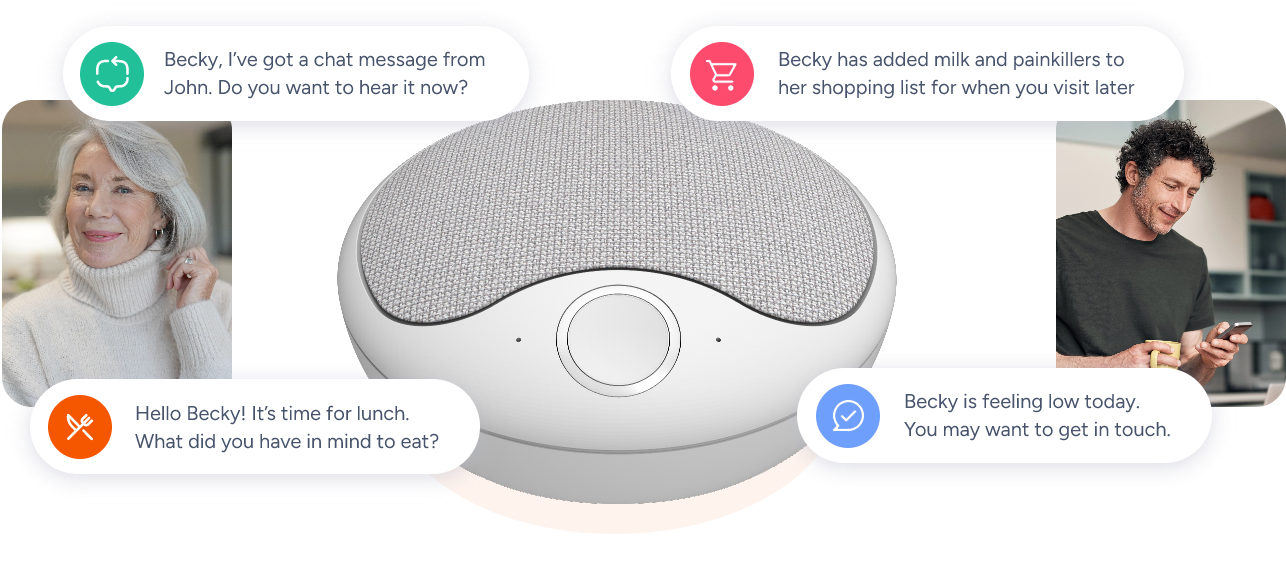The Future of Caregiving: A summary of Sentai’s Round Table Discussion
WRITTEN BY SENTAI ON 03RD APRIL 2025

How Technology and AI are Shaping Tomorrow’s Care Landscape
Health and social care are coming under the spotlight in 2025, with new technologies, increased investment, and transformative changes aimed at tackling the long-standing challenges in caregiving. In November 2024, the UK government announced a £22.6 million investment to support unpaid carers which will be spent on innovative projects such as; helping to identify unpaid carers, digitise records and setting up carer’s support services in hospitals. This was closely followed by new reforms in January 2025 designed to improve adult social care and support the workforce. And with the recent King’s Fund 360 Report on the Future of Care has also highlighted the urgent need for sustainable funding and systemic improvements, it shows the shift towards recognising and addressing the needs of both professional and informal carers.
Sentai recently hosted a round table event, inviting industry leaders from the care sector to discuss the future of caregiving.

Current and Future State of Technology in Care
The caregiving sector has become increasingly digital over the past 5-6 years, with companies now utilising systems for rostering, digital care plans, medication management, and HR. Participants in the Sentai roundtable in March 2025 discussed how the role of care workers might evolve over the next five years, with technology potentially augmenting or changing their responsibilities. While there is recognition that robotics and AI might assist in care provision, it is generally agreed that they will not replace human carers entirely in the near term. This evolution in technology is seen to enhance and complement the role of caregiving, rather than diminish the human element that is so crucial to the profession.
Additionally, these advances are set to enhance the quality of life of the sandwich generation—those simultaneously caring for their children and aging parents—faces unique challenges. This now dominant group often experiences significant stress and emotional strain due to the dual caregiving role. Technology such as Sentai can play a crucial role in supporting these caregivers by providing tools for better organisation, communication, and health monitoring, thereby helping to alleviate some of the pressures they face.
Personal Impact, Systemic Change
Behind the statistics and technological advancements are the human stories that illustrate the profound impact of these changes. Similarly, the new reforms aim to keep older people out of hospitals and living independently at home for longer, directly improving their quality of life. These initiatives are not just systemic changes; they are personal victories for carers and those receiving care. For more insights on the personal impact of caregiving, you can read our blog post on the sandwich generation.
Monitoring Technology and Family Connection
Remote monitoring using sensors or activity tracking has been highlighted as a key benefit, allowing families and care providers to check on clients when carers are not physically present. This technology can track daily routines, medication adherence, sleeping patterns, and potential issues, providing a comprehensive overview of the individual’s well-being. Family members living at a distance particularly benefit from the peace of mind that comes with being able to monitor their loved ones remotely. The concept of a “community hub” was also discussed, which would expand support beyond professional carers to include neighbours and “teenage ambassadors” who could provide quick assistance when needed. This approach aims to create a more integrated and supportive community network for those in need of care.
Ethical Considerations Around AI
The integration of AI in caregiving brings with it a host of ethical considerations. The March roundtable debated whether AI should express emotions, such as saying “I love you,” or remain clearly non-human in interactions with vulnerable people. There are mixed opinions about whether emotional responses from AI are helpful or deceptive, particularly for individuals with dementia. Data privacy and security concerns are also paramount, with questions about who has access to the information being collected. Additionally, the “responsibility gap” was discussed, highlighting the potential issues when care staff rely on AI for decision-making, but the AI provides incorrect information. These ethical dilemmas underscore the need for clear guidelines and regulations to ensure that AI is used responsibly and effectively in caregiving.
Generational Differences
Generational differences play a significant role in the adoption and acceptance of technology in caregiving. Roundtable discussions also highlighted how younger generations might approach technology differently than older ones. The future older generation clients are expected to be more comfortable with technology than current ones, which could facilitate the integration of digital tools in their care. Younger care workers, who are generally more tech-savvy, might also have different expectations about their careers and the role of technology in their work. Understanding these generational differences is crucial for developing effective strategies for technology adoption in caregiving and planning for today as well as preparing for the future.
Business Models and Opportunities
The evolving landscape of caregiving presents numerous business opportunities. Participants discussed potential new hybrid models that combine human care with AI and technology assistance. The ability to offer monitoring services that could lead to additional paid callouts is seen as a promising business opportunity. Technology could help prioritise care visits based on real-time needs rather than rigid schedules, making care delivery more flexible and responsive. However, concerns have been raised about increased expectations and responsibilities without corresponding funding, meaning these models are only made available to those who can afford to pay. Developing sustainable business models that can support technology-enhanced care provision is essential for the future of the industry.
Key Findings
The integration of AI and monitoring technology can fill crucial gaps between scheduled care visits, addressing the “what happens in the other 23 hours” problem. There is potential for new care models that incorporate technology to create more flexible and responsive care delivery. Technology could help address staff shortages by prioritising human care where it is most needed. Both care providers and families benefit from increased transparency and real-time information and the clients can gain companionship and reassurance outside of these hours. However, the use of AI tools like ChatGPT by care staff raises questions about regulation and appropriate use. These key findings highlight the transformative potential of technology in caregiving, as well as the challenges that need to be addressed.
Business Opportunities
The caregiving sector can explore several business opportunities, such as offering monitoring services as a premium add-on to existing care packages and creating tiered response services based on monitoring alerts. Digital or remote care tech can be used in the early stages of an ageing individual, keeping them healthier and more independent for longer, and community-based response networks facilitated by technology can be developed. Predictive analytics can help better allocate care resources and prevent incidents. These opportunities can enhance the efficiency and effectiveness of caregiving, providing better outcomes for those in need of care.

Positives of Technology in Care
Technology in caregiving offers numerous benefits. It provides peace of mind to distant family members, helps address loneliness through companionship technology, and allows for more efficient allocation of care resources. Early intervention is enabled when problems are detected, reducing the need for reactive care. Technology also reduces paperwork and administrative burden, creating potential for preventative approaches. These positives highlight the significant impact that technology can have on improving the quality of care and the well-being of both carers and those they support.
Concerns and Challenges
Despite the many benefits, there are also concerns and challenges associated with the integration of technology in caregiving. Increased expectations without corresponding funding, potential loss of human connection if technology replaces too much human care, and data privacy and security issues are significant concerns. Ethical questions around AI presenting as human-like and challenges in scaling technology-enabled response services also need to be addressed. Additional responsibility for care providers without clear boundaries and training and technology adoption barriers, particularly for older care staff, are other challenges that need to be considered.
Next Steps/Actions
To address these challenges and leverage the benefits of technology in caregiving, several next steps and actions can be taken. Exploring hybrid models that combine human care with technology assistance, considering pilot monitoring technology with tiered response services, and investigating “community hub” models that leverage both technology and informal local support are important steps. Addressing ethical concerns through clear guidelines on AI use in care settings and developing business models that can sustain technology-enhanced care provision are also crucial. These actions can help create a more supportive, efficient, and humane care landscape.
The meeting concluded with participants encouraged to continue these discussions with colleagues and implement actionable insights into their organisations.
Looking Ahead
The future of caregiving lies at the intersection of human compassion and technological innovation. Looking at the future of the industry, the prospects for a more supportive, efficient, and humane care landscape are promising. Digital companions and advanced technologies are enhancing the quality of life for older adults, making caregiving more manageable and effective. Sentai is committed to being at the forefront of this transformation, implementing digital solutions that support carers and those they care for. Through these collaborations, we are witnessing significant changes in the care landscape, driven by digital transformation and a shared commitment to improving lives.
The future of caregiving is bright, with technology and AI playing a crucial role in shaping a more supportive and innovative care landscape. At Sentai we are proud to be part of this journey, working towards a future where carers and those they support can thrive.


